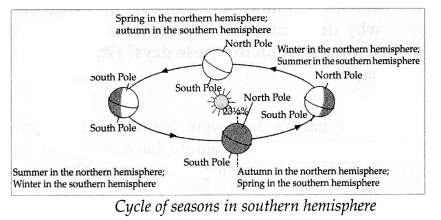Questions Answers For All Chapters – Geography Class 7
How Seasons Occur – Part 2
Q. 1. Complete the statements using correct options:
(1) The apparent movement of the sun means ……..
(a) The sun revolves around the earth in a year
(b) It appears that the sun moves to the north or south in a year.
(c) The earth keeps on changing its position.
Answer: (b) It appears that the sun moves to the north or south in a year.
(2) If the axis of the earth were not tilted ……….
(a) The earth would not have rotated around itself.
(b) The earth would have revolved around the sun with greater velocity.
(c) Different parallels on the earth would have experienced the same climate throughout the year.
Answer: (c) Different parallels on the earth would have experienced the same climate throughout the year.
(3) 21st June and 22nd December are solstice days, that is, ……………..
(a) The sun starts its southward journey from Tropic of Cancer on 21st June and northward journey from Tropic of Capricorn on 22nd December.
(b) The Dakshinayan of the sun takes place between 21st June and 22nd December.
(c) The Uttarayan of the earth takes place between 21st June and 22nd December.
Answer: (a) The sun starts its southward journey from Tropic of Cancer on 21st June and northward journey from Tropic of Capricorn on 22nd December.
(4) The revolution of the earth around the Sun and the tilt of the axis of the earth together are responsible for the following seasons.
(a) Summer, rainy season, Retreat of Monsoon and winter,
(b) Summer, winter and spring
(c) Summer and winter.
Answer: (a) Summer, rainy season, Retreat of Monsoon, and winter.
Q. 2. Answer the following questions.
(1) What leads to the occurrence of seasons?
Answer: The occurrence of seasons is due to the revolution of the Earth around the Sun and the tilt of its axis.
(2) What is the duration of the day on equinox?
Answer: On the equinox, the duration of daytime and nighttime is equal, i.e., 12 hours each.
(3) Why is the effect of the seasons not experienced in the equatorial region?
Answer: The equatorial region does not experience seasonal changes because it receives almost equal sunlight throughout the year.
(4) Why is the sun visible for more than 24 hours during Dakshinayan in the region between the Antarctic Circle and the South Pole?
Answer: During Dakshinayan (from 21st June to 22nd December), the South Pole is tilted towards the Sun, causing continuous daylight for more than 24 hours in regions between the Antarctic Circle and the South Pole.
(5) Why are penguins not found at the North Pole?
Answer: Penguins are native to the Southern Hemisphere, primarily in Antarctica. The Arctic region (North Pole) has different climatic conditions and is home to species like polar bears instead.
Q. 3. Rewrite the following statements after correcting them.
(1) The earth’s velocity varies according to the period of revolution.
Answer: Corrected: The earth’s velocity varies slightly due to its elliptical orbit but does not change significantly with the period of revolution.
(2) If we observe from the northern hemisphere, we see the apparent movement of the sun.
Answer: Corrected: If we observe from the Earth, we see the apparent movement of the sun.
(3) The dates of equinox change every year.
Answer: Corrected: The dates of equinox remain approximately the same every year (21st March and 23rd September).
(4) North Canada experiences summer from September to March.
Corrected: North Canada experiences summer from June to September.
(5) When it is summer in South Africa, Australia has winter.
Corrected: When it is summer in South Africa, Australia also has summer as both are in the Southern Hemisphere.
(6) Duration of daytime is less on the vernal and autumnal equinoxes.
Corrected: Duration of daytime and nighttime is equal on the vernal and autumnal equinoxes.
Q. 4. Spot the error in the diagram given below.
Answer:
- Spring Equinox – 21st March
- Summer Solstice – 21st June
- Winter Solstice – 22nd December
Q. 5. Draw a diagram showing the cycle of seasons in the southern hemisphere.
Answer:



Leave a Reply